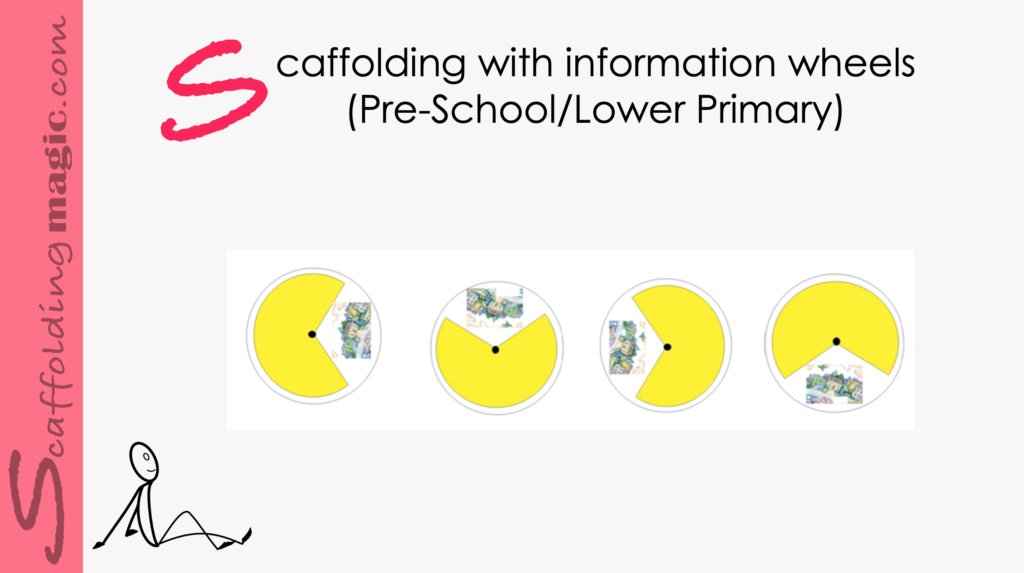You caught a beauty!!!
Download PDF of scaffold here.
Using information wheels in lessons is a wonderful way of giving our students the opportunity to learn through, among other learning styles, kinesthetic interaction. They’ll be pulling from past knowledge, using deductive reasoning, negotiating meaning, and learning new subject matter, all at the same time. Studies showthat learning is enhanced when students acquire knowledge through active processes that engage them. Literacy is a combination of recognising and matching oral and written language. The most effective ways of promoting literacy is to make vocabulary visibleand to create high encounters with these words for your students – in interactive ways. Using wheels to scaffold vocabulary before you read a story can help. Below you’ll see how you can help your students to match words with images with an information wheel. information wheel.
The scaffold is based on the positive transference theory which is when learners use past experiences to affect learning and performance in a new situation; they transfer knowledge from one place to another. Creating opportunities for this in the classroom gives students the opportunity to develop this skill, thus helping them to become more self-sufficient and effective learners. With Information Wheels, students use positive transfer skills to fill in holes, make educated connections and correct their own work in the moment.
We use here an example from the wonderfully imaginative and beautifully illustrated book I Miss You, Stinky Faceby Lisa McCourt.
Step by step:
- Make copies of 8-10 illustrations of the story you’re going to read to your students.

- Reduce them and make four copies of each of them, keeping the sets separate.
- In the first copy, delete one element from the illustration and leave a blank there.
- In the second copy, delete a different element from the illustration (but the part of the illustration that you deleted in the first aperture is visible)
- For the third and fourth copy, remove yet two other different elements from the illustration, leaving the rest visible.
(The object being to have a different element missing in each of the copies of the illustration.)
- Make a wheel for every pair of students in your class.
- Paste the four copies of each set in a wheel and attach the top part of the wheel so that only one illustration is shown at a time (see example below).

- Model the activity for your students. Show one illustration with art missing and elicit suppositions about what doesn’t show.
Example:
First frame
Teacher: This illustration is from a wonderful book we’re going to read called I Miss You, Stinky Face. What do we see in the illustration?
Students: A house, a dragon, clouds, trees.
Teacher: Yes. What colour is the dragon?
Students: Green.
Teacher: And we see a blank space, don’t we? What do you think is missing?
Students: A dog. A cat.
Teacher: Maybe. Let’s see. Let’s look at the next image. It’s the same illustration, but something else is missing, and what we didn’t see before we can see now. What was missing in the first image?
Students:. A car.
Teacher: Yes, that’s right. There was no car in the first image we saw. Now we see that there’s a car. What colour is the car?
Students: Pink.
Etc.
- Give one wheel to each pair of students. They work together, repeating the dynamic.
- Formative Assessment: Show the illustrations again with parts missing. Students say what parts of the illustration is missing. The academic language should come more naturally by this time.
- Reflection: Students tell their partners how they felt about using the wheels and trying to figure out what part of the illustration was missing.
How to teach Academic Language to Pre-Schoolers
video explanation of scaffold…

How to teach Academic Language to Pre-Schoolers



Scaffoldingmagic.com is your entryway into DYNAMIC bilingual learning methodologies, such as Phenomenon-Based Learning, CLIL, EMI, and ESL. You’ll find ways to implement critical thinking tools (DOK) to promote higher level thinking, the growth mindset, instill an ethic of excellence, deep reflection on learning, and all through multi-cultural, interdisciplinary activities. We have the keys to turning competences into action and to creating collective efficacy in your school so you move ahead as a unified, enthusiastic team.



